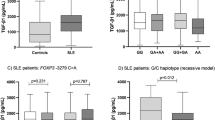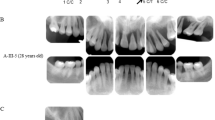Abstract
Human type II low-affinity receptor for immunoglobulin G (FcγRII) constitutes a clustered gene family consisting of FcγRIIA, IIB and IIC genes. FcγRIIB is unique in its ability to transmit inhibitory signals in B cells via immunoreceptor tyrosine-based inhibitory motif (ITIM). B-cell activation and subsequent elevated production of IgG are the immunopathological features of inflammatory disease such as periodontitis. To determine whether an association with periodontitis susceptibility exists, genetic polymorphisms of FcγRIIB were examined in Japanese patients with aggressive periodontitis (AGP) and chronic periodontitis (CP), and in the race-matched healthy controls (HCs). A significant difference was observed in the distribution of FcγRIIB−232I/T allele (exon 5) between the AGP and HC groups, with enrichment of the 232T in the AGP group (P=0.006). In addition, the FcγRIIB-nt 646−184A/G allele (intron 4) distribution was significantly different between the CP and HC groups, with enrichment of the nt 646−184A in the CP group (P=0.011). These results document the association of FcγRIIB gene polymorphisms with susceptibility to periodontitis in the Japanese.
This is a preview of subscription content, access via your institution
Access options
Subscribe to this journal
Receive 6 digital issues and online access to articles
$119.00 per year
only $19.83 per issue
Buy this article
- Purchase on Springer Link
- Instant access to full article PDF
Prices may be subject to local taxes which are calculated during checkout


Similar content being viewed by others
References
Qiu WQ, de Bruin D, Brownstein BH, Pearse R, Ravetch JV . Organization of the human and mouse low-affinity FcγR genes: duplication and recombination. Science 1990; 248: 732–735.
Warmerdam PAM, Nabben NMJM, van de Graaf SAR, van de Winkel JGJ, Capel PAJ . The human low affinity immunoglobulin G Fc receptor IIC gene is a result of an unequal crossover event. J Biol Chem 1993; 268: 7346–7349.
Muta T, Kurosaki T, Misulovin Z, Sanchez M, Nussenzweig MC, Ravetch JV . A 13-amino-acid motif in the cytoplasmic domain of FcγRIIB modulates B-cell receptor signalling. Nature 1994; 368: 70–73.
Budde P, Bewarder N, Weinrich V, Schulzeck O, Frey J . Tyrosine-containing sequence motifs of the human immunoglobulin G receptors FcγRIIb1 and FcγRIIb2 essential for endocytosis and regulation of calcium flux in B cells. J Biol Chem 1994; 269: 30636–30644.
D'Ambrosio D, Hippen KH, Minskoff SA, Mellman I, Pani G, Siminovitch KA . Recruitment and activation of PIT1C in negative regulation of antigen receptor signaling by FcγRIIB1. Science 1995; 268: 293–296.
Brooks DG, Qiu WQ, Luster AD, Ravetch JV . Structure and expression of a human IgG FcRII (CD32): functional heterogeneity is encoded by the alternatively spliced products of multiple genes. J Exp Med 1989; 170: 1369–1385.
Tartour E, de la Salle H, de la Salle C, Teillaud C, Camoin L, Galinha A et al. Identification, in mouse macrophages and in serum, of a soluble receptor for the Fc portion of IgG (FcγR) encoded by an alternatively spliced transcript of the FcγRII gene. Int Immunol 1993; 5: 859–868.
Takai T, Ono M, Hikada M, Omori H, Ravetch JV . Augmented humoral and anaphylactic responses in FcγRII-deficient mice. Nature 1996; 379: 346–349.
Bolland S, Ravetch JV . Spontaneous autoimmune disease in FcγRIIB-deficient mice results from strain-specific epistasis. Immunity 2000; 13: 277–285.
Tonetti MS, Mombelli A . Early-onset periodontitis. 1999 International Workshop for a classification of periodontal diseases and conditions. Ann Periodontol 1999; 4: 39–53.
Kornman KS, Crane A, Wang H-Y, di Grovino FS, Newman MG, Pirk FW et al. The interleukin-1 genotype as a severity factor in adult periodontal disease. J Clin Periodontol 1997; 24: 72–77.
Hart TC, Kornman KS . Genetic factors in the pathogenesis of periodontitis. J Periodontol 2000 1997; 14: 202–215.
Mackler BF, Frostad KB, Robertson PB, Levy BM . Immunoglobulin bearing lymphocytes and plasma cells in human periodontal disease. J Periodont Res 1977; 12: 37–45.
Yuan ZN, Schreurs O, Gjermo P, Helgeland K, Schenck K . Topical distribution of FcγRI, FcγRII and FcγRIII in inflamed human gingiva. J Clin Periodontol 1999; 26: 441–447.
Ogawa T, McGhee ML, Moldoveanu Z, Hamada S, Mestecky J, Mcghee JR et al. Bacteroides-specific IgG and IgA subclass antibody-secreting cells isolated from chronically inflamed gingival tissues. Clin Exp Immunol 1989; 76: 103–110.
Horino K, Yoshie H, Hara K . Correlation between serum and gingival crevicular fluid antibodies and periodontal status. J Dent Res 1989; 68: 1688–1690.
Yasuda K, Sugita N, Kobayashi T, Yamamoto K, Yoshie H . Seven single nucleotide substitutions in human Fcγ receptor IIB gene. Tissue Antigens 2001; 58: 339–342.
Kyougoku C, Dijistelbloem HM, Tsuchiya N, Hatta Y, Kato H, Yamaguchi A et al. Fcγ receptor gene polymorphisms in Japanese patients with systemic lupus erythematosus: contribution of FCGR2B to genetic susceptibility. Arthritis Rheum 2002; 46: 1242–1254.
Grossi SG, Zambon JJ, Ho AW, Koch G, Dunford RG, Machter EE et al. Assessment of risk for periodontal disease. I. Risk indicators for attachment loss. J Periodontol 1994; 65: 260–267.
Martinez-Canut P, Lorca A, Magán R . Smoking and periodontal disease severity. J Clin Periodontol 1995; 22: 743–749.
Kobayashi T, Sugita N, van der Pol W-L, Nunokawa Y, Westerdaal NAC, Yamamoto K et al. The Fcγ receptor genotype as a risk factor for generalized earlyonset periodontitis Japanese patients. J Periodontol 2000; 71: 1425–1432.
Kobayashi T, van der Pol W-L, van de Winkel JGJ, Hara K Sugita N, Westerdaal NAC et al. Relevance of IgG receptor IIIb (CD16) polymorphism to handling of Porphyromonas gingivalis: implications for the pathogenesis of adult periodontitis. J Periodont Res 2000; 35: 65–73.
Ravetch JV, Lanier LL . Immune inhibitory receptors. Science 2000; 290: 84–89.
Pearse RN, Kawabe T, Bolland S, Guinamard R, Kurosaki T, Ravetch JV . SHIP recruitment attenuates FcγRIIB-induced B cell apoptosis. Immunity 1999; 10: 753–760.
Pricop L, Redecha P, Teillaud J-L, Frey J, Fridman WH, Sauté S, Fridman C et al. Differential modulation of stimulatory and inhibitory Fcγ receptors on human monocytes by Th1 and Th2 cytokines. J Immunol 2001; 166: 531–537.
Kobayashi T, Yamamoto K, Sugita N, van Spriel AB, Kaneko S, van de Winkel JGJ et al. Effective in vitro clearance of Porphyromonas gingivalis by Fcα receptor I (CD89) on gingival crevicular neutrophils. Infect Immun 2001; 69: 2935–2942.
Samuelsson A, Towers TL, Ravetch JV . Anti-inflammatory activity of IVIG mediated through the inhibitory Fc receptor. Science 2001; 291: 484–486.
Kobayashi T, Yamamoto K, Sugita N, van der Pol W-L, Yasuda K, Kaneko S et al. The Fcγ receptor genotype as a severity factor for chronic periodontitis in Japanese patients. Periodontol 2000; 72: 1324–1331.
Schei O, Waehaug J, Lovdal A, Arno A . Alveolar bone loss related to oral hygiene and age. J Periodontol 1959; 30: 7–16.
Acknowledgements
We are grateful to Dr Naoyuki Tsuchiya (Department of Human Genetics, The University of Tokyo) for valuable suggestions, and also to Dr Jun Ohashi (Department of Human Genetics, The University of Tokyo) for statistical guidance. This work was supported by Grant-in-Aids for Scientific Research (12557191, 12672033, 13470461 and 13557189) from the Ministry of Education, Culture, Sports, Science and Technology, Japan, and the fund for Scientific Promotion of Tanaka Industries Co. Ltd, Niigata, Japan.
Author information
Authors and Affiliations
Corresponding author
Rights and permissions
About this article
Cite this article
Yasuda, K., Sugita, N., Kobayashi, T. et al. FcγRIIB gene polymorphisms in Japanese periodontitis patients. Genes Immun 4, 541–546 (2003). https://doi.org/10.1038/sj.gene.6364021
Received:
Revised:
Accepted:
Published:
Issue Date:
DOI: https://doi.org/10.1038/sj.gene.6364021
Keywords
This article is cited by
-
Identification of candidate regulators of mandibular bone loss in FcγRIIB-/- Mice
Scientific Reports (2021)
-
FcγRIIB in autoimmunity and infection: evolutionary and therapeutic implications
Nature Reviews Immunology (2010)



